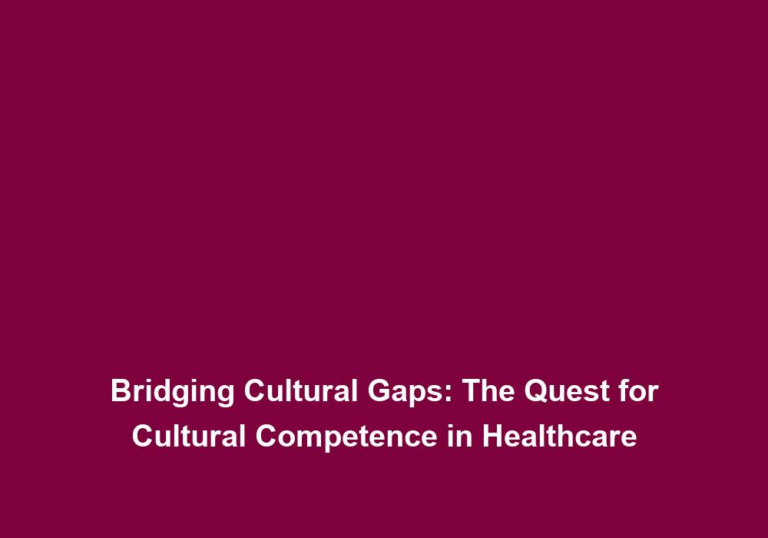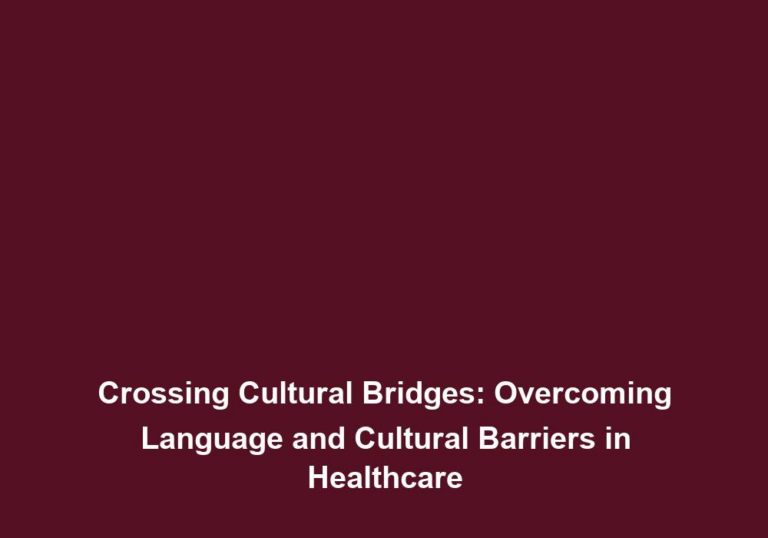Lost in Translation? Navigating Language and Cultural Hurdles in Patient Care
Language and cultural barriers can pose significant challenges in patient care. In today’s diverse society, healthcare professionals must be equipped with the necessary skills to effectively communicate and understand patients who come from different linguistic and cultural backgrounds. Failure to navigate these hurdles can result in misunderstandings, misdiagnoses, and compromised patient outcomes. In this article, we will discuss the importance of overcoming language and cultural barriers in patient care and provide strategies for healthcare professionals to enhance communication and promote cultural competence.
The Impact of Language Barriers in Patient Care
When patients and healthcare providers do not share a common language, effective communication becomes incredibly challenging. Misunderstandings may arise, leading to inaccurate medical histories, miscommunication of symptoms, and confusion regarding treatment plans. This can have serious consequences on patient care and overall healthcare experience.
To overcome language barriers, healthcare professionals should utilize professional interpreters instead of relying on family members or friends. Trained interpreters can ensure accurate and confidential communication between patients and healthcare providers. Interpretation services can be accessed via phone, video, or in-person, depending on the facility’s resources and patient preferences. This allows for clear and effective communication and reduces the risk of medical errors.
In addition to using interpreters, healthcare professionals should also use plain language when communicating with patients with limited English proficiency. Using clear and concise language, avoiding medical jargon or complex terminology, helps bridge the gap between providers and patients. Explaining medical concepts in simple terms can enhance understanding and ensure patients are well-informed about their condition and treatment options.
To further facilitate communication, written materials such as educational materials, instructions, and consent forms should be provided in multiple languages. This empowers patients to take control of their healthcare journey and facilitates their comprehension of important healthcare information. Healthcare facilities should invest in translation services or leverage online resources to ensure the availability of materials in languages commonly spoken by their patient population.
The Role of Cultural Barriers in Patient Care
Cultural differences can also create hurdles in patient care. Cultural beliefs, values, and practices significantly influence an individual’s perception of health, illness, and healthcare. When healthcare providers are unaware of or disregard these cultural nuances, misunderstandings and conflicts may arise.
For example, certain cultural groups may have specific dietary preferences or restrictions. Failure to acknowledge and respect these cultural practices can lead to dissatisfaction, non-compliance with treatment plans, and poor health outcomes. Similarly, notions of modesty, spirituality, and family involvement in decision-making vary across cultures. Healthcare professionals must recognize and accommodate these differences to establish trust and provide patient-centered care.
To overcome cultural barriers, healthcare professionals should actively seek knowledge about different cultural practices, beliefs, and healthcare-seeking behaviors. This cultural competence can be achieved through attending diversity training sessions, reading relevant literature, and engaging with community organizations. Such understanding helps healthcare providers tailor their care to accommodate individual patient needs and preferences.
Establishing trust is crucial in overcoming cultural hurdles. Healthcare professionals should demonstrate respect for patients’ cultural backgrounds and actively listen to their concerns. Taking the time to understand patients’ perspectives, beliefs, and values can foster empathy and strengthen the provider-patient relationship. Building trust allows for effective communication and collaboration in the decision-making process.
Strategies to Overcome Language and Cultural Barriers
-
Utilize professional interpreters: When language barriers exist, healthcare professionals should rely on professional interpreters rather than relying on family members or friends. Trained interpreters can ensure accurate and confidential communication between patients and healthcare providers. Interpretation services can be accessed via phone, video, or in-person, depending on the facility’s resources and patient preferences.
-
Use plain language: To enhance understanding, healthcare professionals should use clear and concise language, avoiding medical jargon or complex terminology. Explaining medical concepts in simple terms can help bridge the gap between providers and patients with limited English proficiency.
-
Provide written materials in multiple languages: Offering educational materials, instructions, and consent forms in multiple languages can empower patients and facilitate their comprehension of important healthcare information. Healthcare facilities should invest in translation services or leverage online resources to ensure the availability of materials in languages commonly spoken by their patient population.
-
Cultivate cultural competence: Healthcare professionals should actively seek knowledge about different cultural practices, beliefs, and healthcare-seeking behaviors. This cultural competence can be achieved through attending diversity training sessions, reading relevant literature, and engaging with community organizations. Such understanding helps healthcare providers tailor their care to accommodate individual patient needs and preferences.
-
Establish trust and empathy: Building trust is crucial in overcoming cultural hurdles. Healthcare professionals should demonstrate respect for patients’ cultural backgrounds and actively listen to their concerns. Taking the time to understand patients’ perspectives, beliefs, and values can foster empathy and strengthen the provider-patient relationship.
-
Engage interpreters in shared decision-making: Involving interpreters in shared decision-making processes can ensure that patients fully understand the available treatment options, risks, and benefits. This collaborative approach respects cultural values related to family involvement and empowers patients to actively participate in their healthcare decisions.
-
Seek feedback and continuous improvement: Healthcare facilities should welcome feedback from patients, especially regarding language and cultural challenges they may have faced. This feedback can inform quality improvement initiatives and help organizations implement more effective strategies to address language and cultural barriers in patient care.
Remember, effective communication and cultural competence are ongoing processes. Healthcare professionals must continuously strive to improve their skills, knowledge, and awareness to provide equitable and patient-centered care to individuals from diverse linguistic and cultural backgrounds.
In conclusion, language and cultural barriers in patient care can significantly impact healthcare outcomes. By implementing strategies such as utilizing professional interpreters, using plain language, providing written materials in multiple languages, cultivating cultural competence, building trust, involving interpreters in shared decision-making, and seeking continuous improvement, healthcare professionals can effectively navigate these hurdles. By embracing diversity and promoting inclusivity, we can ensure that all patients receive the care they deserve, regardless of language or cultural differences.
Note: This article is written in markdown format and can be easily converted to other formats as needed.






